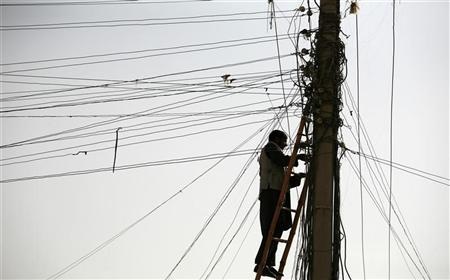Afghanistan Set To 'Waste' $335 Million US Aid
An Afghan man repairs electricity cables along the streets of Kabul

NEW DELHI: The office of the Special Inspector General for Afghanistan Reconstruction (SIGAR) has once again indicated that money being given in the form of aid to Afghanistan is being wasted. According to a recent letter addressed to William Hammink, USAID Mission Director for Afghanistan from John F. Sopko, the Special Inspector General for Afghanistan Reconstruction, a $335 million USAID investment in the Tarakhil Power Plant in Kabul, Afghanistan is in danger of being wasted or severely underused.
The letter outlines concerns that the Afghan government remains unwilling or unable to maintain the power plant. “[T]he blackouts and lack of power throughout Kabul resulting from the avalanches raises questions regarding the efficacy of those actions and the commitment and ability of the Afghan government to operate the Tarakhil Power Plant as needed or when absolutely necessary,” John Sopko said in the letter.
“USAID OIG found that since the handover in June 2010, the power plant has been severely underused and operated at just 2.2 percent of installed power production capacity,” Sopoko said. “[Afghanistan’s national power utility] had limited operations since accepting responsibility for the facility because it couldn’t afford to operate the plant—the fuel alone required to operate the plant as intended was estimated to cost approximately $245 million per year.”
The high cost of operation has resulted in the Afghan government relegating the power plant to the status of “an emergency power source.” The plant went unused during this year’s avalanches.
SIGAR has often pointed to the danger of critical aid being wasted in Afghanistan. Recently, a report released in January concluded that Afghanistan is unable to adequately track personnel and pay within its police force despite more than 13 years and billions of dollars of outside assistance.
As a majority of foreign troops are withdrawn from Afghanistan, the US will continue to spend $300 million annually on the Afghan National Police (ANP). Since the start of the Afghan war, the US has spent $3.6 billion dollars on police salaries and payroll costs, with US taxpayers paying $1.3 billion of that tally.
The problem, according to SIGAR, is that these payments have been made and are continuing to be made without any guarantees the money is going where it’s supposed to.
Similarly, in a report last year on the challenges facing Afghanistan, corruption figured foremost on the list, with the report noting that initial U.S. strategy in Afghanistan fostered a political climate conducive to corruption. Massive military and aid spending overwhelmed the Afghan government’s ability to absorb it. This, coupled with weak oversight, created opportunities for corruption. The report placed onus of the blame on lack of political will on the part of both the international community and the Afghan government to combat corruption resulting in a culture of impunity.
Focusing on US strategy in a subsection of the report titled “too much money, too little oversight,” the report noted that “the deluge of military and aid money into Afghanistan” overwhelmed the Afghan government’s ability to absorb these funds. This, coupled with weak oversight by U.S. implementing agencies and other international donors, “created ample opportunities for corruption.”
The report noted that reconstruction assistance has dwarfed the size of the Afghan economy. For instance, according to the World Bank, Afghanistan total GDP in 2010 amounted to about $15.9 billion. That year, Congress appropriated President Obama’s’ request for more than $16 billion to build Afghanistan’s security forces, government and economy. This did not include the tens of billions of dollars spent that year on US military operations in Afghanistan. Since 2010, Congress has provided nearly $64 billion for reconstruction programmes.
The report highlighted the need to arrive at a clear, shared definition of corruption and a full appreciation of how Afghans perceive corruption. It further noted that neither the international community nor the Afghan government have been fully committed to combatting corruption and called for the need to develop a comprehensive anti corruption strategy.
Corruption was identified as a deep rooted structural problem, with internal factors including weak institutional capacity at the national and provincial levels, weak legislative and regulatory frameworks, weak enforcement of laws and regulations, poor and/or non merit based recruitment of public officials, low salaries and insufficient numbers of law enforcement officials, lack of complaint mechanisms and systems for public security, and illegal profits from cross border smuggling and opium trade.
The report stated that “grand corruption undermine public trust,” thereby impeding Afghan revenue collection, jeopardizing economic development and thwarting efforts to establish the rule of law. The report calls for “establishing and sustaining a long term, coordinated, multi front attack on corruption… for the future of the country and its people.”



